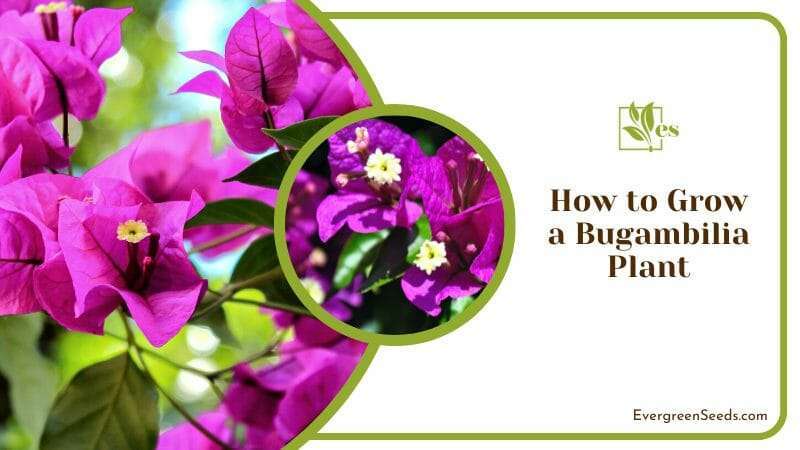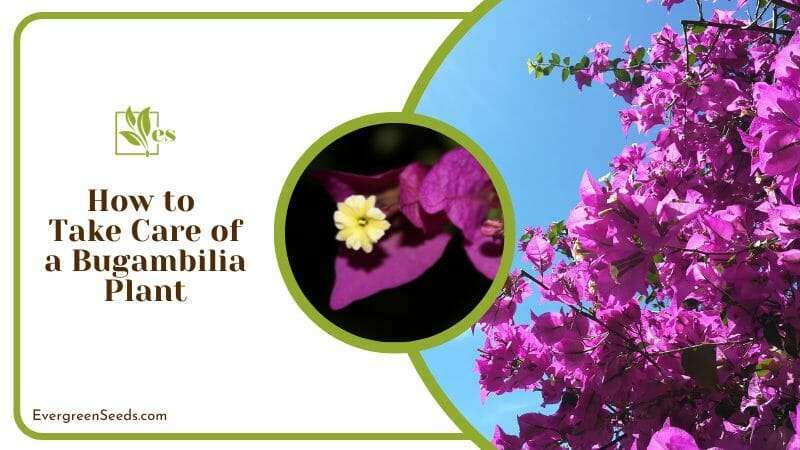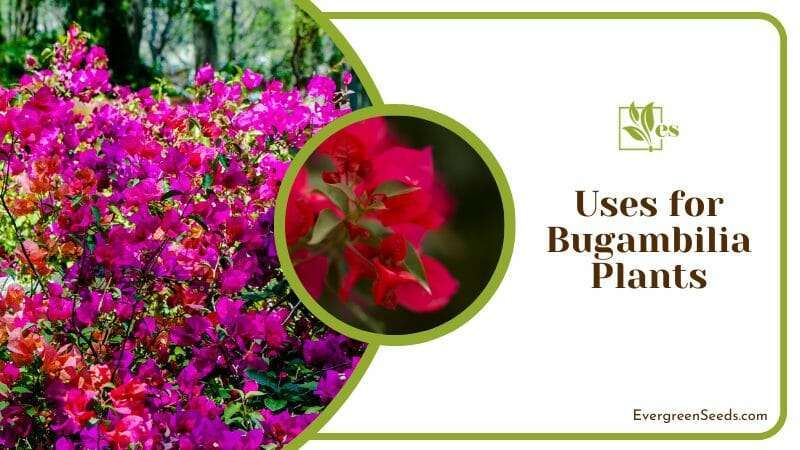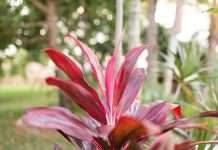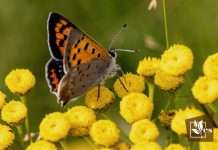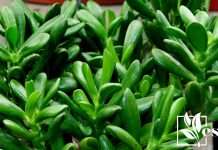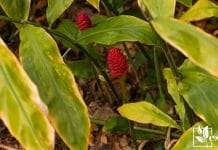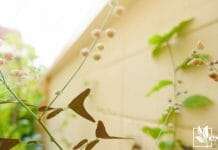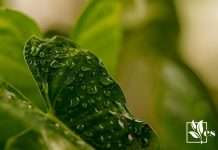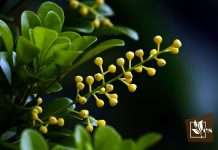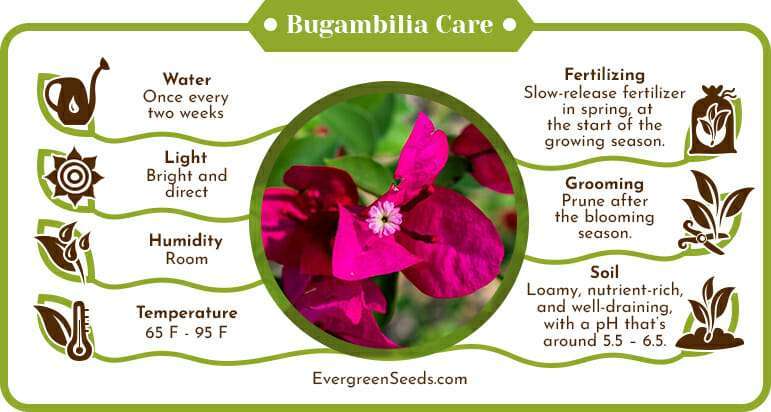 Bugambilia plants of the Nyctaginaceae family are a great way to bring vivid colors into your home or garden.
Bugambilia plants of the Nyctaginaceae family are a great way to bring vivid colors into your home or garden.
Renowned for their showy blooms, you’ll find a wide array of bugambilia colors to choose from.
They can be a little tricky to grow, but our experts will discuss everything you need to know in this guide.
JUMP TO TOPIC
What is Bugambilia?
Bugambilia plants, also known as bougainvillea, are a genus of ornamental plants native to South America. They are popular among gardeners due to their vivid, abundant flowers. They are a landscaping and ornamental staple around the world.
The actual flowers of the bugambilia plants are small, white, and not very showy. The highlight, however, is the flower bracts, leaf-shaped inflorescences that surround the actual flowers in pairs of 3 or 6. They’re thin, with a papery texture, which is why bugambilia is often called ‘the paper flower.’
Indeed, when referring to ‘bugambilia flowers,’ it’s these bracts that are being described.
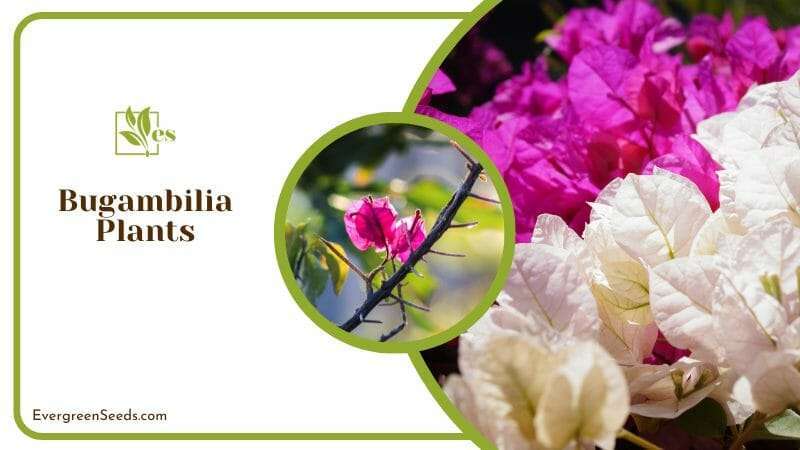
Bugambilia comes in many colors, ranging from white, yellow, and orange to shades of fuchsia, magenta, red, burgundy, and purple. There are over 300 varieties of bugambilia to choose from. Most of them are hybrids, bred for the unique colors of the flowering bracts.
In some cases, you can even find variegated bugambilias. The most common, or the ‘classic’ varieties, are:
- Bougainvillea spectabilis: also known as the great bougainvillea. It is the best known and most spectacular variety. It produces a thick, woody stem and can climb to a height of almost 40 feet (12 meters). The flowering bracts are usually pink, purple, or red, although some can also be white and even orange.
- Bougainvillea glabra: also known as the lesser bougainvillea. It is the best choice if you’re looking for a shrubbing variety. Often, the glabra grows to a height of around 10 feet (3 meters) and has a very long flowering season. If you want to grow bugambilia as a bonsai, this variety is by far the one most gardeners recommend.
- Bougainvillea peruviana: native to Peru, this variety typically produces widely spaced branches. It can be grown as either a large shrub or a climbing vine. The flower bracts are usually purple or magenta.
Depending on the variety, you can grow bugambilia plants as either a shrub, a climbing vine, or even a tiny tree. All bugambilia plants have stems covered in thin, sharp thorns. In their native range, they are evergreen plants but will lose their foliage when exposed to cold temperatures or drought.
How to grow a bugambilia plant
Bugambilia is a tropical plant that enjoys plenty of sun and warmth. If grown in a suitable climate, such as U.S. Hardiness Zones 9b to 11, it will produce its iconic flowers almost year-round.
Here’s what you need to know if you want to grow your own.
1. Growing bugambilia outdoors
 Light
Light
Plant your bugambilia in a part of your garden that gets total sun exposure. This plant needs at least 6 hours of light each day to thrive and at least 8 hours of sunlight to produce those stunning flowers. Insufficient light will not only stunt its growth but also result in dense foliage and very few blooms.
 Soil
Soil
The ideal soil for growing bugambilia should be loamy, nutrient-rich, and well-draining, with a pH that’s around 5.5 – 6.5. However, this plant will also tolerate clay soils and mildly salty, sandy, slightly acidic, or alkaline soils. We recommend using soil amendments to improve drainage, such as pine bark or leaf mold, and cover the top 3 inches (7.5 cm) of the soil with compost.
 Temperature
Temperature
The ideal temperature range for growing bugambilia outdoors is between 65 °F and 95 °F (18 °C to 35 °C). This plant is not frost tolerant. Although it’s an evergreen, retaining its foliage through the colder part of the year, it will start shedding leaves if temperatures drop below 50 °F (10 °C). Simultaneously, if temperatures stay above 100 °F (38 °C) for extended periods, this can result in the plant not blooming. Also, you may notice your bugambilia to start losing leaves.
– Spacing
Ensure that your bugambilia plants have plenty of space for their roots by planting them at least 40 inches (1 meter) apart. Spacing depends significantly on which variety you’re growing and how. For example, bugambilia shrubs grown as a hedge can be planted closer together if you provide them with regular pruning. Bugambilia trees, on the other hand, typically grow as tall as 30 feet (9 meters) and need to be at least 10 feet (3 meters) apart.
 Water
Water
Bugambilia has a high tolerance to drought. It prefers to be watered rarely but deeply. Once every two weeks, watering once the top 2 inches (5 cm) of the soil are dry to the touch should do the trick. As the plant matures and becomes established, you can reduce the watering schedule even more. It’s best to underwater when in doubt, as bugambilia plants are very susceptible to root rot.
 Fertilizers
Fertilizers
Like most flowering ornamental plants, bugambilia is a heavy feeder and needs regular fertilizer applications. Use a slow-release fertilizer in spring, at the start of the growing season, or apply a liquid fertilizer solution once a month through the blooming season.
Aim for a nutrient ratio of 10-10-10 or 20-20-20. Bugambilia needs a balanced mix of nitrogen and phosphate to bloom. Still, too much nitrogen will encourage leaf and stem growth instead of flowers.
2. Growing bugambilia in containers
Bugambilia is an excellent plant for container growth, especially if you live in a colder climate. The plant will be smaller and easier to manage, and it will reward you with a lush display of flowers for many months.
When growing Bugambilia in containers, there are two main things to pay close attention to:
 Light
Light
Most indoor plants don’t have access to the same amount of light as those growing in your garden. Therefore, pick the sunniest part of your house, where your Bugambilia can get a minimum of 6 hours of bright, direct light each day. A room with southern or western exposure would be perfect.
 Water
Water
Even if you plant your Bugambilia in a container with drainage holes and use a well-draining soil mix, the chance of overwatering it is much higher. The soil in your garden will allow water to seep through and also evaporate at a better rate. Indoors, however, you will need to check the soil moisture periodically.
We suggest giving your Bugambilia a good watering only when the top 2 inches (5 cm) of the soil are completely dry. Also, avoid bottom watering, as this won’t give you a proper indication of the actual soil moisture levels.
For everything else, check our outdoor growing guide above.
How to take care of a bugambilia plant
Bugambilia is easy to care for. It needs an annual prune and trim before the flowering season, followed by regular pinching of the dead flower bracts. We’ll take a closer look at your care and maintenance essentials in this guide.
But before we get started, there’s a crucial question worth asking:
– Are bugambilia plants toxic?
The sap of bugambilia plants is mildly toxic. In some cases, it can cause severe skin irritations and allergies, similar to those caused by poison ivy or poison oak. If you ingest stems in large quantities, they can also cause nausea, vomiting, and other gastrointestinal distress types. As a result, it’s safer to keep them away from pets and small children.
Also, keep in mind that bugambilia plants have thorns. So whenever you’re performing care or maintenance tasks on this plant, make sure to wear a sturdy pair of gardening gloves.
 Pruning and trimming
Pruning and trimming
The best time to prune your bugambilia is in winter or early spring or after the blooming season has ended. Depending on how big your plant is, the way you prune and trim it may vary.
In the case of large bugambilia trees, you will need a pair of pruning shears or even a hand saw. Cut any branches that are too long or too heavy or branches that don’t fit the shape you want for your bugambilia. In the case of shrubs or hedges, you can use pruning shears and trim the ends of branches. It will essentially encourage new growth in spring.
Throughout the flowering cycle, you can further trim the new growth to give the plant a fuller look.
During the blooming season, make sure to regularly pinch the dead flower heads, followed by the stem’s tips the flower was growing on. It will ensure that your bugambilia will produce new stems and buds. With proper maintenance, your bugambilia will flower for at least six months each year.
– Repotting
If you’re growing bugambilia in containers, you’ll be happy to hear that it enjoys being a bit root-bound. Some gardeners believe that it helps it produce more abundant flowers. What we recommend is that you keep it in the same pot until you start seeing roots poking through the drainage holes. Once that happens, it’s a sign that you can repot it to a container about two times larger.
When repotting your bugambilia, remember that the roots are very delicate. To get started, grab the plant from the bottom of the stem and gently lift it out of the original pot. Fill the new container with soil mix, and make a hole in the middle, roughly the size of the plant’s root ball. Carefully place the root ball inside the hole, then cover with soil. Do not try to untangle, prune or handle the roots too much. It will send the bugambilia into shock, and it may take weeks to recover.
Pests and diseases
Bugambilia is a sturdy plant, and it’s resistant to most pests and diseases. It is most sensitive to root rot, but you can easily avoid this if you stick to a good watering schedule.
Aphids are the most common pest, especially if you’re growing bugambilia outdoors. You can get rid of them by giving your plants a good hosing down now and then.
Caterpillars such as the bugambilia looper will occasionally chew on the leaves. Luckily, they make a tasty snack for birds and other small animals, so you don’t need to apply pesticides to get rid of them.
For bugambilia grown indoors, keep an eye out for spider mites, and spray the leaves’ underside with a water and isopropyl alcohol solution to remove them.
Uses for bugambilia plants
Bugambilia plants are best known for their high ornamental value. But did you know that the flower bracts are also edible?
They are often used in traditional medicine due to their antibacterial, anti-inflammatory, and antioxidant properties and aid with ulcers, diabetes, viral infections, or liver problems.
One of the most popular ways to enjoy edible flower bracts is to make bugambilia tea. Pick the fresh bracts, remove the stems, rinse well, then steep in boiling water for 10 minutes. Feel free to add some ginger or cinnamon for a touch more aroma. For something more substantial, bugambilia flower bracts can also be eaten raw, in salads or soups, and even deep-fried in batter.


